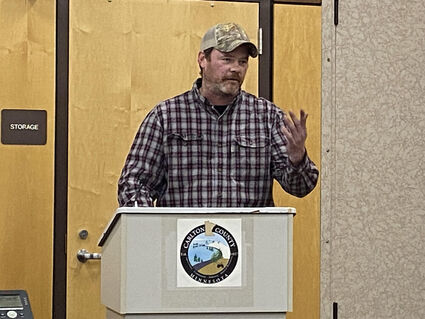Volunteer ambulance 'not sustainable'
February 3, 2023

Brady Slater
Carlton ambulance manager Erik Bergstedt addresses a crowd of roughly 40 people Jan. 25 at the Carlton County Transportation Building. Ambulance personnel and township officials from the area were presented with a new request for staffing and additional funding.
Bolstering Carlton ambulance service, costs pitched to townships
A proposal to create two full-time positions atop the city of Carlton's all-volunteer ambulance service was met with optimism by officials from surrounding townships Jan. 25.
"You did a professional job here tonight," Silver Brook Township board chair Duane Laveau said. "You probably sold Silver Brook Township just by the professionalism here tonight."
The proposal to beef up ambulance service came in front of more than 40 local ambulance personnel and elected officials from Carlton and Wrenshall, as well as Atkinson, Blackhoof, Mahtowa, Silver Brook, Thomson, Twin Lakes, Wrenshall and Sawyer townships. The meeting was held at Carlton County's Transportation Building.
Under the proposal, two full-time emergency medical technicians would staff the ambulance during weekday hours, with the remainder of the schedule filled using paid volunteers from the city's pool of 60.
One of the full-time EMTs would also coordinate the service, scheduling the volunteers while also working to fortify, even expand, the service. Last year, the service fielded 790 medical calls, including mutual aid to surrounding areas already covered by their own ambulance services.
A volunteer model isn't equipped long-term to handle the volume currently being experienced, sources said.
"A volunteer staffing model in a service with 700-plus calls (annually), and a continued increase in calls, I don't see as a sustainable model," said Mark Jones, CEO of OakPoint Inc., based in Warren, Minnesota.
Jones was hired to conduct a nearly year-long study of the city's ambulance service. He's currently performing a similar analysis of the Cromwell and Wright ambulance service, and has worked with Thomson Township, parts of which are served by both Carlton and the Cloquet Area Fire District.
"You might get by," Jones told the crowd. "But the fear is there will be shifts and times of day nobody can meet the request."
Carlton fire chief Derek Wolf agreed.
"We currently don't have an issue," Wolf said. "But we see a light at the end of the tunnel we need to address, and that's why we're here."
He appealed to local elected officials to fill a funding gap that would increase with the addition of full-time staffing from its current deficit level of roughly $26,000 annually to $175,000.
Currently, the operation relies on modestly paid volunteers. The city of Carlton bills surrounding communities served by the ambulance service a total of $87,000 per year, but it's a voluntary contribution. Last year, the city collected just over $37,500 from the surrounding communities served by Carlton ambulance.
The newspaper used a Minnesota Data Practices Act request to the city of Carlton to learn which jurisdictions contributed funds in 2022. Carlton ($18,612), Atkinson ($3,067), Mahtowa ($1,570), Thomson ($3,112), Twin Lakes ($25,737) and Sawyer ($4,082) were the full roster of contributors.
"No community failed to meet its financial obligation to Carlton ambulance services since all contributions are purely voluntary," the city said in a statement to the Pine Knot.
Funding from municipalities is used to cover the gap between revenues and expenses, which include $14 per hour paid to ambulance volunteers who fill slots covering every minute of every day throughout the year.
The volunteers are a menagerie of college students, nurses, and paramedics.
"You've got a lot of great people in this room that do this," Jones said. "Can it continue for days, weeks, months? Yes, I'm confident, because these folks work really hard at it. But into the future? I don't see it as a sustainable model at all."
Currently, the city uses a 10-hour-per-week manager, Erik Bergstedt, to schedule and administer the business of the ambulance service. It's not enough, he and others said.
"The big change ... as an ambulance service, is we've turned from technicians into clinicians," Bergstedt said.
He described how even basic life support services have evolved from a "scoop and go" to the hospital model to one featuring more immediate lifesaving treatments. Even basic life support ambulances - as opposed to the rolling emergency rooms that are advanced lifesaving ambulances - can diagnose certain heart attacks in the field and communicate with hospital cardiologists, delivering heart attack patients right into Duluth's regional cardiac catheterization laboratories while bypassing emergency rooms. Today's basic life support ambulances can prepare intravenous ports, so hospital medication is later delivered without delay. They carry carbon monoxide monitors to identify poisoning, and aggressive treatments for breathing issues.
"Our staff are very engaged and we ask a lot of them," Bergstedt said. "We train a lot."
Most of the ambulance coverage in the state is provided by 20 main providers, sources said, such as Mayo Clinic Ambulance. Carlton's service fits into a smaller pool of community-run ambulances. It's one of 85 basic life support ambulances in the state all struggling and having the same conversations, said Buck McAlpin, a lobbyist for the Minnesota Ambulance Association.
"We're going to have to pay for a level of readiness, and it's not going to be out of user fees," McAlpin told the crowd.
The lion's share of Carlton's 2022 revenue of $552,000 came from user fees paid for by Medicare and Medicaid, commercial insurance, and workers' compensation. But those sources don't pay full freight. They pay an antiquated cost of transport, and are basically getting medical attention for free, the sources said. Recouping 40 percent of actual costs billed, as Carlton does, is considered a good return.
"You can bill $1,000; you can bill $9,000; you could bill $100,000, but Medicare pays $400 for every transport," Jones said.
Which is partly why townships and municipalities were being asked to cover costs to restructure a service that already runs a deficit with every call it makes.
"We don't want to lose this service," Wolf said, citing dwindling cash reserves. "But we can't continue to lose money either."
Jones argued that full-time staffers would pay for themselves.
"When (you) invest in leadership ... that manager finds ways to decrease costs and finds new sources of revenue whether that's grants, or philanthropic efforts," Jones said. "They generally try to build a service so that it provides more value to the community, offsetting the need for funding."
Wolf was asked about establishing a taxing district, like the one the legislature created for the Cloquet Area Fire District earlier this century to help fund fire and advanced lifesaving services. Wolf said it takes a long time, and other sources argued that rural areas struggle to find a tax base to support a fire district.
"We like the way we're doing it," Wolf said. "We just need everybody's participation."
Township officials present at the meeting were expected to deliver the proposal to their full boards, and report back to the city of Carlton within a month. City officials said they would like to know what the overall commitment will be prior to undertaking the 2023 budgeting process.


